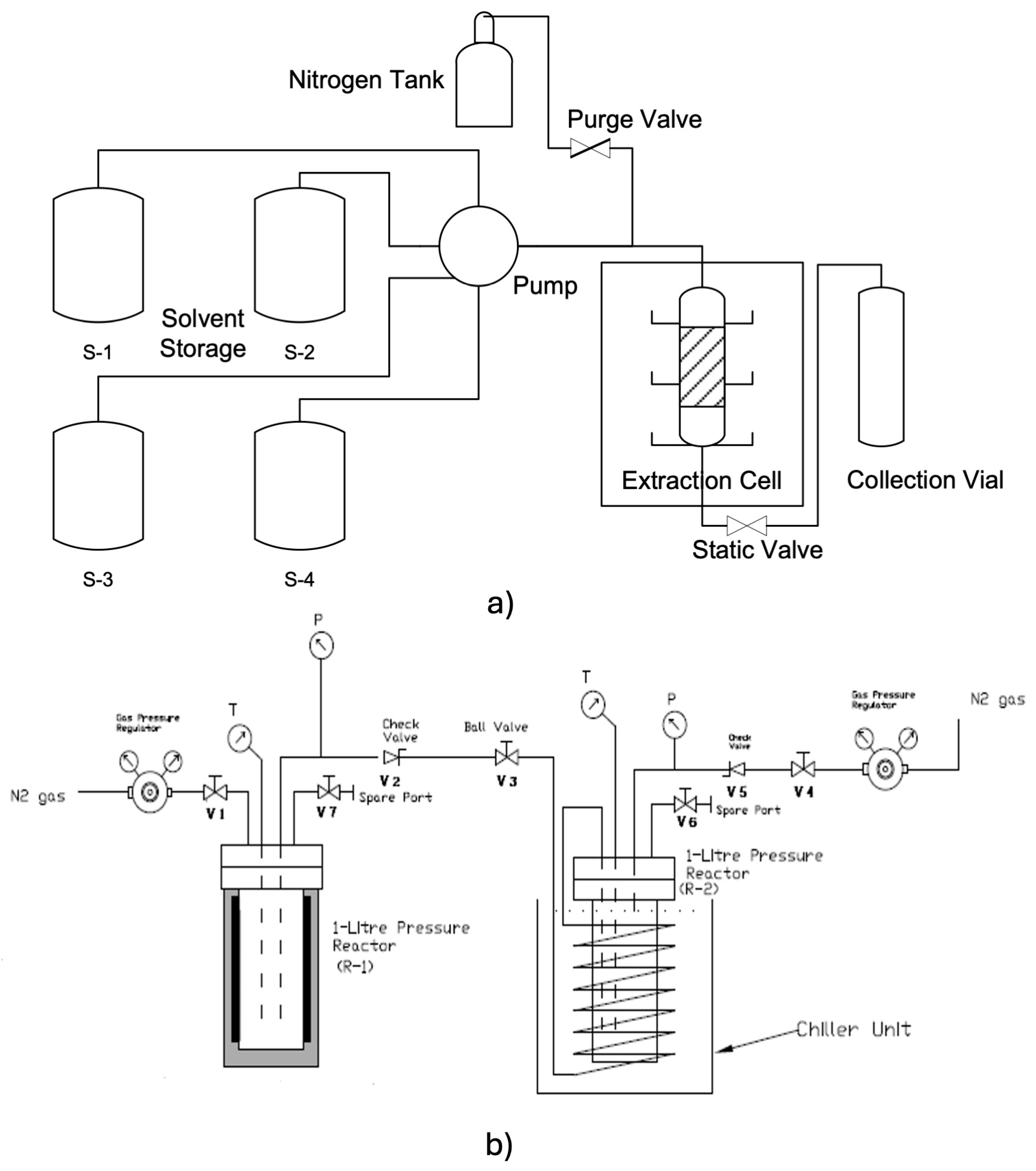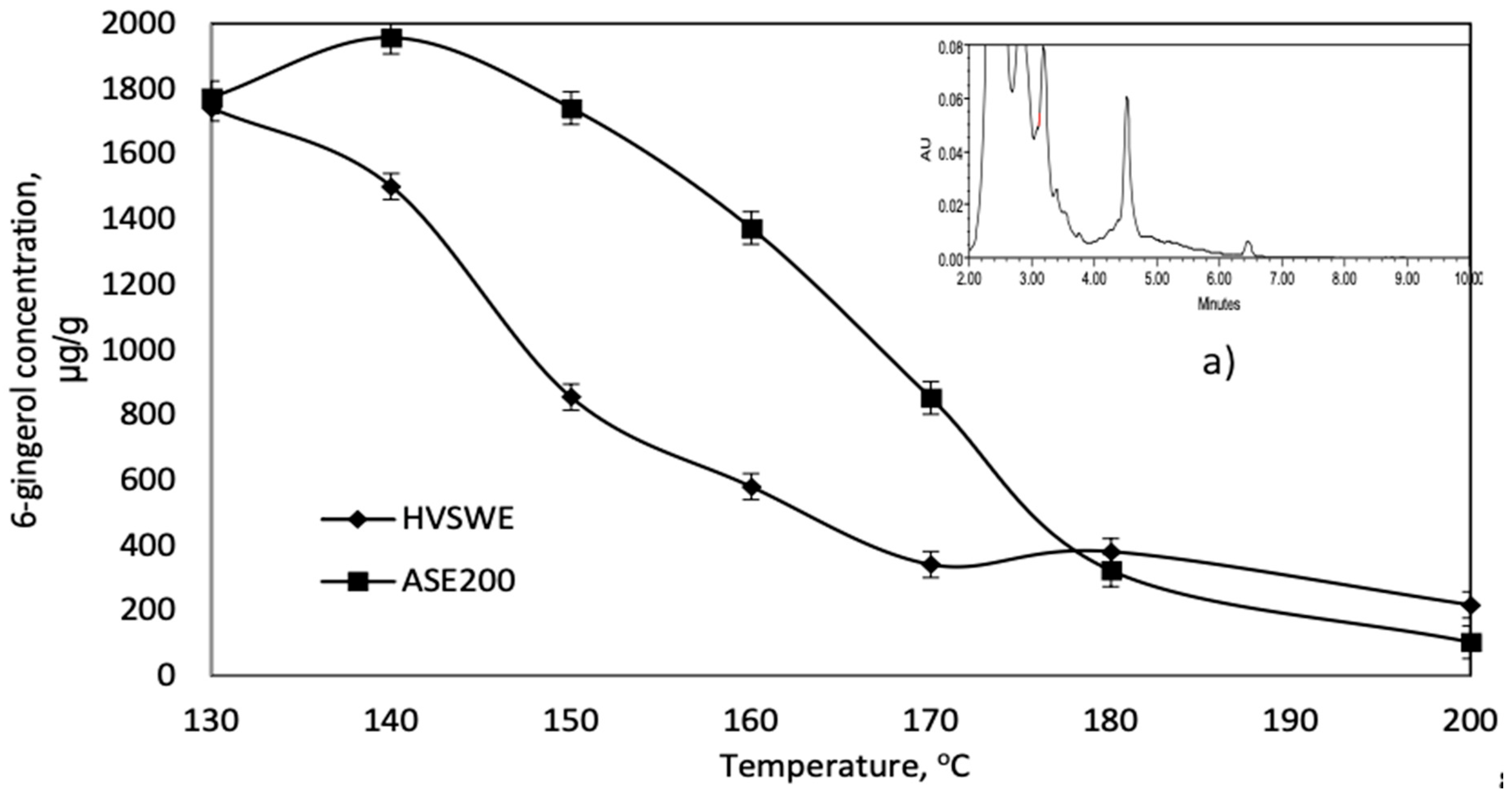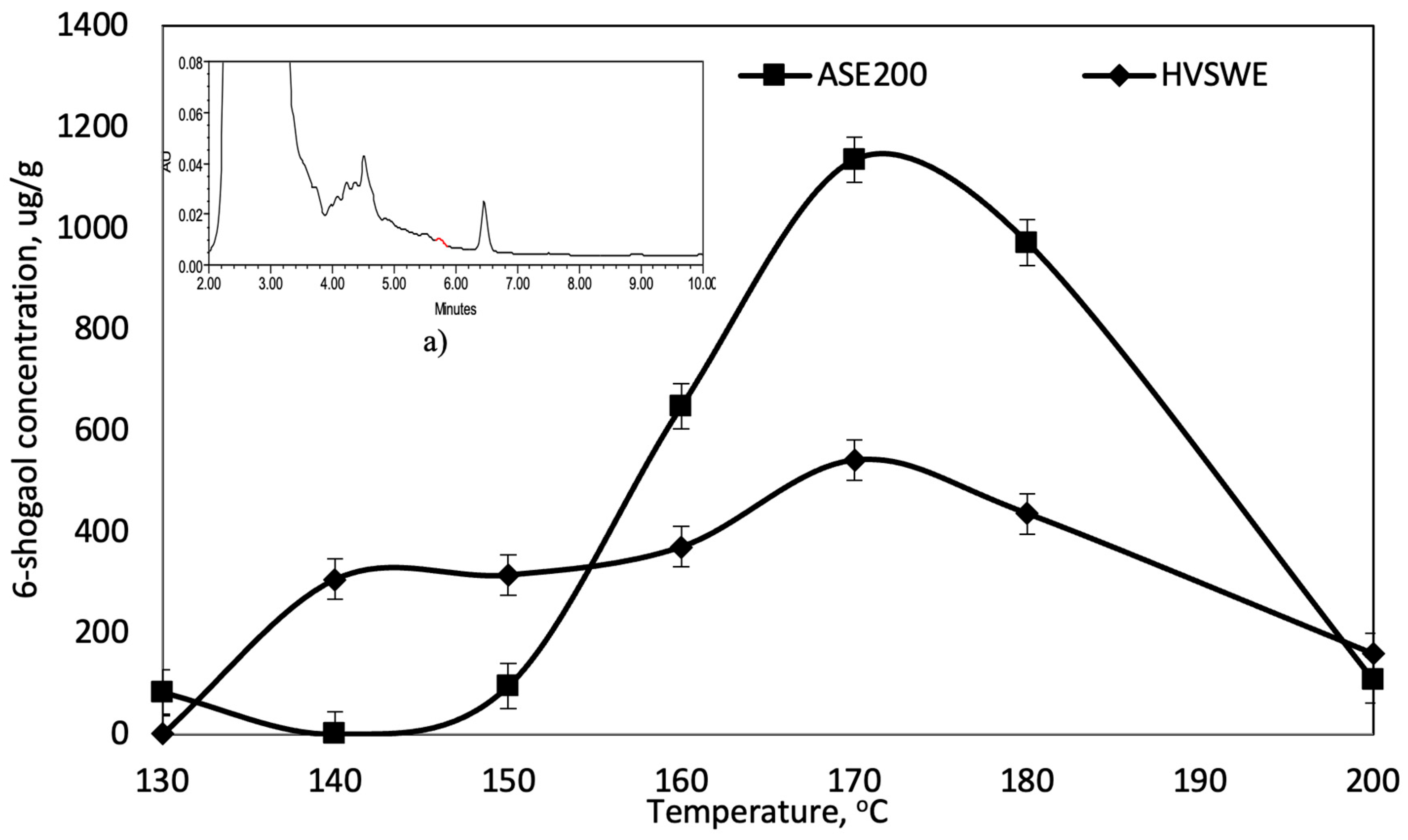The Effect of Temperature on the Upscaling Process of 6-Gingerol and 6-Shogaol Extraction from Zingiber officinale Using Subcritical Water Extraction †
Abstract
1. Introduction
2. Methodology
2.1. Material and Chemical
2.2. SWE Process
2.2.1. Accelerated Solvent Extraction System (ASE 200)
2.2.2. HVSWE
2.3. Compound Identification
2.4. Statistical Analysis
3. Result and Discussion
3.1. Effect of Temperature on the 6-Gingerol Concentration
3.2. Effect of Temperature on the 6-Shogoal Concentration
4. Conclusions
Author Contributions
Funding
Institutional Review Board Statement
Informed Consent Statement
Data Availability Statement
Acknowledgments
Conflicts of Interest
References
- Megan, C.; Skye, M.; Wolfgang, M.; Elizabeth, I.; Anna, L. Therapeutic health effects of ginger (Zingiber officinale): Updated narrative review exploring the mechanisms of action. Nutr. Rev. 2023, 81, 1213–1224. [Google Scholar]
- Promdam, N.; Panichayupakaranant, P. [6]-Gingerol: A narrative review of its beneficial effect on human health. Food Chem. Adv. 2022, 1, 100043. [Google Scholar] [CrossRef]
- Bischoff-Kont, I.; Fürst, R. Benefits of Ginger and Its Constituent 6-Shogaol in Inhibiting Inflammatory Processes. Pharmaceuticals 2021, 14, 571. [Google Scholar] [CrossRef] [PubMed]
- Anh, N.H.; Kim, S.J.; Long, N.P.; Min, J.E.; Yoon, Y.C.; Lee, E.G.; Kim, M.; Kim, T.J.; Yang, Y.Y.; Son, E.Y.; et al. Ginger on Human Health: A Comprehensive Systematic Review of Randomized Controlled Trials. Nutrients 2020, 12, 157. [Google Scholar] [CrossRef] [PubMed]
- Razak, A.M.; Zakaria, S.N.A.; Abdul Sani, N.F.; Ab Rani, N.; Hakimi, N.H.; Mohd Said, M.; Tan, J.K.; Gan, H.K.; Mad Nordin, M.F.; Makpol, S. A subcritical water extract of soil grown Zingiber officinale Roscoe: Comparative analysis of antioxidant and anti-inflammatory effects and evaluation of bioactive metabolites. Front. Pharmacol. 2023, 14, 1006265. [Google Scholar] [CrossRef] [PubMed]
- Sulejmanović, M.; Milić, N.; Mourtzinos, I.; Nastić, N.; Kyriakoudi, A.; Drljača, J.; Vidović, S. Ultrasound-assisted and subcritical water extraction techniques for maximal recovery of phenolic compounds from raw ginger herbal dust toward in vitro biological activity investigation. Food Chem. 2024, 437, 137774. [Google Scholar] [CrossRef] [PubMed]
- Yulianto, M.E.; Purwantisari, S.; Hartati, I.; Nisa, Q.A.K. and Nyamiati, R.D. Subcritical reactive extraction of shogaol and gingerol: Effect of time and temperature. Int. Food Res. J. 2022, 29, 857–863. [Google Scholar] [CrossRef]
- Md Sarip, M.S.; Nik Daud, N.M.A.; Mohd Zainudin, M.A.; Ibrahim, L.H.; Saidi, S.A.; Idham, Z.; Anuar, A. Quantitative analysis method for Zingiber officinale water extract using high-performance liquid chromatography. Adv. Mat. Res. 2024, 13, 233–241. [Google Scholar]
- Alonso-Riaño, P.; Ramos, C.; Trigueros, E.; Beltrán, S.; Sanz, M.T. Study of subcritical water scale-up from laboratory to pilot system for brewer’s spent grain valorization. Ind. Crops Prod. 2023, 191 Pt A, 115927. [Google Scholar] [CrossRef]




Disclaimer/Publisher’s Note: The statements, opinions and data contained in all publications are solely those of the individual author(s) and contributor(s) and not of MDPI and/or the editor(s). MDPI and/or the editor(s) disclaim responsibility for any injury to people or property resulting from any ideas, methods, instructions or products referred to in the content. |
© 2025 by the authors. Licensee MDPI, Basel, Switzerland. This article is an open access article distributed under the terms and conditions of the Creative Commons Attribution (CC BY) license (https://creativecommons.org/licenses/by/4.0/).
Share and Cite
Md Sarip, M.S.; Nik Daud, N.M.A.; Idham, Z.; Mohd Zainudin, M.A.; Abu Bakar, A.R.; Ruslan, M.S.H.; Abdul Aziz, A.H. The Effect of Temperature on the Upscaling Process of 6-Gingerol and 6-Shogaol Extraction from Zingiber officinale Using Subcritical Water Extraction. Eng. Proc. 2025, 87, 74. https://doi.org/10.3390/engproc2025087074
Md Sarip MS, Nik Daud NMA, Idham Z, Mohd Zainudin MA, Abu Bakar AR, Ruslan MSH, Abdul Aziz AH. The Effect of Temperature on the Upscaling Process of 6-Gingerol and 6-Shogaol Extraction from Zingiber officinale Using Subcritical Water Extraction. Engineering Proceedings. 2025; 87(1):74. https://doi.org/10.3390/engproc2025087074
Chicago/Turabian StyleMd Sarip, Mohd Sharizan, Nik Muhammad Azhar Nik Daud, Zuhaili Idham, Mohd Asraf Mohd Zainudin, Amirul Ridzuan Abu Bakar, Muhammad Syafiq Hazwan Ruslan, and Ahmad Hazim Abdul Aziz. 2025. "The Effect of Temperature on the Upscaling Process of 6-Gingerol and 6-Shogaol Extraction from Zingiber officinale Using Subcritical Water Extraction" Engineering Proceedings 87, no. 1: 74. https://doi.org/10.3390/engproc2025087074
APA StyleMd Sarip, M. S., Nik Daud, N. M. A., Idham, Z., Mohd Zainudin, M. A., Abu Bakar, A. R., Ruslan, M. S. H., & Abdul Aziz, A. H. (2025). The Effect of Temperature on the Upscaling Process of 6-Gingerol and 6-Shogaol Extraction from Zingiber officinale Using Subcritical Water Extraction. Engineering Proceedings, 87(1), 74. https://doi.org/10.3390/engproc2025087074







